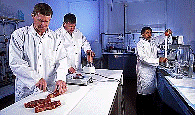United States Department of Agriculture: Agricultural Research Service, Lincoln, Nebraska

Roman L. Hruska U.S. Meat Animal Research Center: Reports
Date of this Version
1988
Document Type
Article
Abstract
It is now widely recognized that consumers do not accept meat with excessive quantities of fat. To make cuts of meat acceptable to the consumer, packers and retailers are forced to trim much of the subcutaneous fat. If this consumer demand persists, the meat industry will be forced to change its production system to produce leaner cattle.
Subcutaneous fat cover is thought to act as an insulator, retarding rapid temperature decline and consequently preventing cold-induced toughness. Cold-induced toughening is a phenomenon observed when prerigor excised muscles are exposed to cold ( < 50° F) temperatures. However, there is no conclusive evidence that cold-induced toughening actually happens under current meat industry practices of slaughtering and carcass handling. The objectives of these experiments were to examine the effect of the removal of subcutaneous fat and high temperature conditioning on beef tenderness. High temperature conditioning (HTC) - storage of carcasses at high temperatures (e.g. 78° F) for 3 to 6 hr after slaughter - was included to attempt prevention of cold-induced toughness in defatted carcasses.


Comments
Published in Beef Research Program Progress Report (1988) No. 3: 45-46